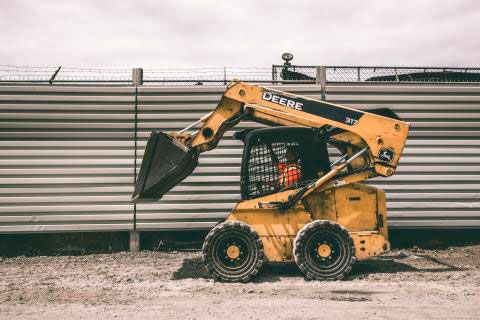Spreading Soil with a Skid Steer
In the late 1830s, John Deere was a highly regarded blacksmith in Grand Detour, Illinois. He knew his business, finished work on time, and charged fair prices. Deere also was incessantly observant. Once he figured out how to solve a pain point for local farmers – machine a plow that would last – his business took off. By 1842, he had built and sold hundreds of plows, and had begun customizing them for different customers as needed. That tradition continues today. Every John Deere Skid Steer loader or other pieces of heavy machinery can be custom-ordered with more than 100 optional accessories. These include attachments like snowplow attachments, different bucket sizes, angle brooms, utility grapples, rotary tillers, augers, pallet forks, rollers, and many more. Few pieces of heavy machinery can be as productive and versatile. Today, it is a go-to machine for many industries and jobs, from farming, agriculture, landscaping, and construction – and John Deere is the industry leader in all regards.

Do This to Spread Soil
As an experienced operator, spreading topsoil with a skid steer from John Deere should be a simple task. And perhaps it is, but challenges could arise based on the landscape itself and ground conditions before you can start work. If this is the case, then keep reading.
- What does the general landscape look like? Filled with debris? Pitted with holes or trenches?
- Operating heavy machinery often requires a permit from the local municipality. Do you need one?
- One of your first tasks should be to contact your local utility company. They can send someone out to identify the location of buried electric, gas, or water lines.
- Remember that you have been hired to work for someone else, so it is your responsibility to understand and agree with their goals before the job begins.
- Any shrubbery, trees, concrete, or other items bigger than 2-3 inches in diameter have to be taken out before spreading soil.
- If the job means you have to do a lot of digging, you may be forced to backfill to level the ground before getting to the real task of spreading topsoil.
- Take measurements of the area to know how much topsoil is needed.
- Measuring first should never be minimized. This will tell you how much soil to buy and deliver.
- Now, go through the process of rough grading the area and slope the grade away from nearby structures for water run-off.
- The ground should be tilled to a depth of about two inches before spreading topsoil.
- If you are working in a residential area, are you interfering with neighbors or nearby goings-in?
- Check the pH level of the soil and make adjustments as needed.
- Always wear job-appropriate clothing and safety gear, like gloves, safety goggles, closed-toe shoes or boots, and a hard-hat.
- Keep hand tools at the ready, like shovels and rakes, and get ready for some manual work.
Tips for Spreading Spoil
The expert and finely spread soil is the key to a beautiful lawn or garden area, both of which are great for entertainment and create more usable green space on residential property. Follow these tips before spreading topsoil.
- Check the property to make sure there are no hazards nearby, like animals or people in the area. You also should be aware of any vehicles, buildings, or equipment in the vicinity.
- What is the weather forecast? Free water is great for the lawn and garden, but rain or other precipitation is a bummer if you have a yard or two of topsoil to spread around. Avoid days like this; otherwise, your machine could get trapped in the mud, and that is never good.
- Spreading soil for any job is tailor-made for an accessory called a radial boom. This component is great for all sorts of related work: Backfilling, digging and grading at different lift heights.
- Use the bucket or boom at a 45-degree angle for rougher grades. This also will help you drag the soil backward.
- Want a finer grade? Then adjust the bucket parallel and near the ground. If this is your goal, choose a 20-degree angle.
- You also can create a better grade and pack the soil firmer by moving the bucket across the soil when working.
- A toothed bucket is another good option.
- The more dirt, the better, so begin with as large a quantity as you can get away with, as long as your workspace can fit it all.
- Practice, practice, practice. Spread dirt around to get used to the process. Mistakes are easy to fix. Eventually, you will come up with your own method and style of spreading soil with a John Deere skid steer.
- Spread the first layer by simply driving forward.
- Once the topsoil has been spread and leveled, you may want to use a roller attachment. This is an almost-necessary accessory to flatten the soil and force out any imperfections.
- Remember those hand tools you brought along? Now that the primary job is finished, you may need to do a few manual touch-ups to get everything just right.
What Kind of Skid Steer do You Need?
Before renting a John Deere, ask yourself the following questions:
- What are the goals?
- How much time do I have, or do I have to work within a set schedule?
- Where will I be working?
- What is the landscape like?
- How much dirt will I need?
- How far will the topsoil have to be moved?
Answering each of these questions and any others you come up with will help you finish the job successfully. Landscaping and agricultural work are tailor-made for using a skid steer, with spreading soil near the top of the list. Be sure to choose a machine that will do what you need. Optional components are great conversation starters at a tailgating party, but a hammer attachment may be extreme. Agriculture and landscaping are two popular applications for a skid steer, especially when it comes to spreading soil. And the biggest machinery available is not necessarily the best. There are two popular sizes to choose from:
- A 50-horsepower model that is considered “Small frame” (1,750 pounds), and
- A 50- to 70-horsepower version referred to as “Medium frame” (1,750 to 2,200 pounds).
Why choose a smaller skid steer? Because it is great for jobs in areas where space is at a premium, such as between houses in many neighborhoods. A John Deere skid steer is very nimble, able to turn and navigate in confined spaces, and is a great choice for spreading soil and other “finish” landscaping jobs.
Both a small or medium-frame skid steer will fulfill your needs, but one may be more suited than the other depending on the factors just mentioned. So choose wisely.
Operating a Skid Steer: The Basics
Large machinery such as a John Deere Skid Steer should not be taken lightly. Operating it demands a degree of practice and knowledge that cannot be served by merely reading or working in a computer simulation.
- Read the operator’s manual. Some product documentation is available as a smartphone application.
- What kind of maintenance schedule is required?
- When it comes to safety instructions, read them twice. A skid steer, even a small frame model, is “light on its feet” and can change direction quickly and tip easily if abused.
- You should practice in a spacious, open area free of distractions.
- Understand how the controls work; normally, there is one on each armrest to guide the machine left or right.
- Always wear your seatbelt when the machine is being operated.
- Start the engine.
- Practice moving: First forward and back, and then right and left.
- You also should familiarize yourself with how the bucket and other attachments work, and practice using them.
- Like many other drivable machineries, a skid steer is designed with one operator in mind.
- When seated in the cab, do you see any blind spots?
- Do not operate a John Deer or other machinery when impaired or physically disabled.
- Slopes, ditches, and embankments are a risk, so work carefully when they are nearby.
- The machine should always be powered down and locked, preferably in a secured location.
Safety is Job One
A skid steer and other large machinery are designed for complex, intensive work and can be dangerous if not treated with respect. You must adhere to all safety instructions, like the kind of safety equipment to use and clothing to wear. According to government reports, hundreds of landscape workers die each in job site-related mishaps. Be aware of the following common dangers when working with a skid steer.
- The presence of bystanders, including fellow co-workers who may not realize the machine is in operation.
- Accidental crushing or entrapment.
- Accidental rollovers.
- Heavy, drivable machinery is easier to tip than you may think.
Finally, be aware of the danger of severe bodily injuries that may not be fatal, such as to the fingers, hands, feet, or other areas. These can be debilitating and require long-term care.

